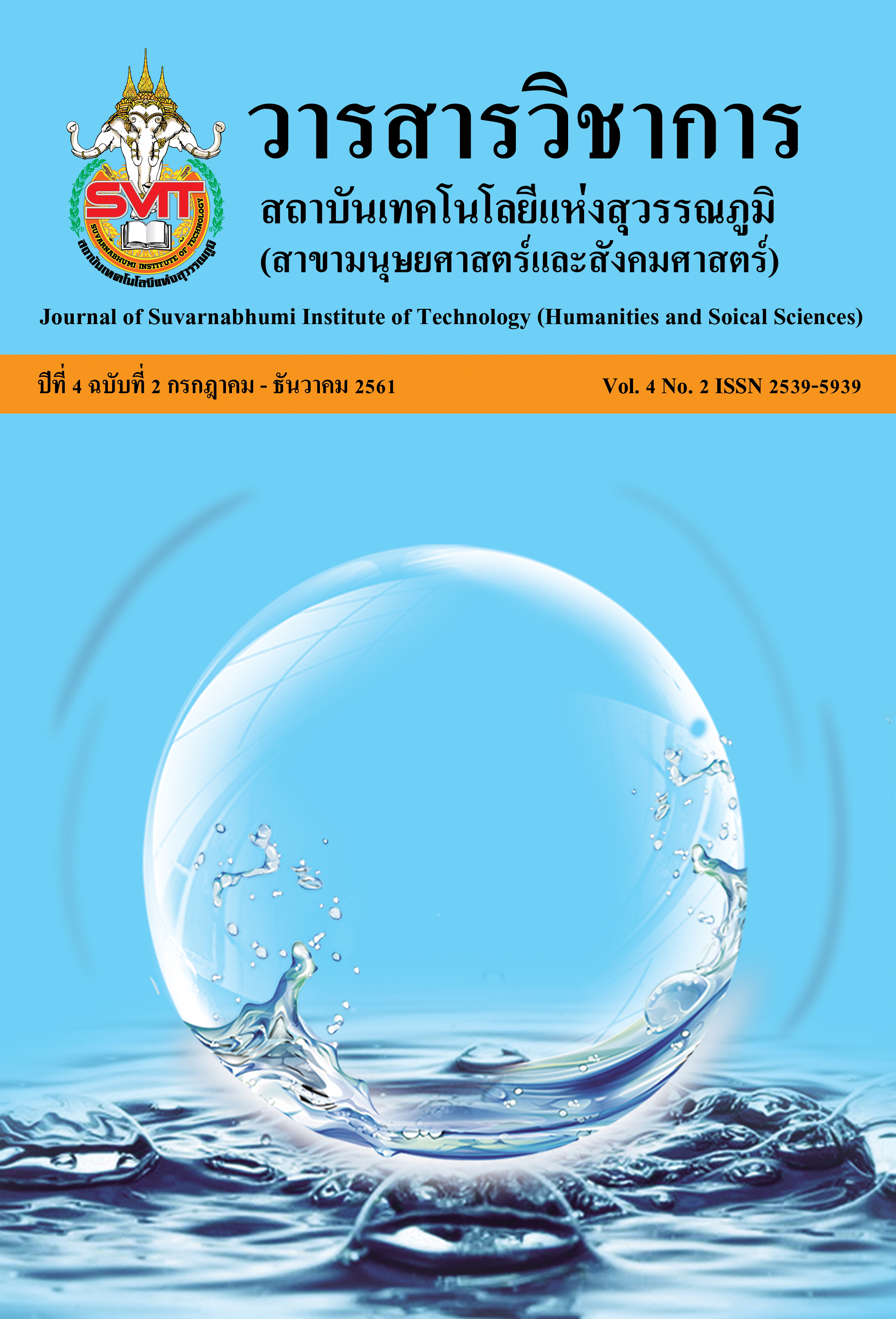THE DEVELOPMENT OF 4.0 MARKETING STRATEGY OF AUTOMOBILE INDUSTRY
Keywords:
Marketing 4.0, perception and buying decision process, automobile industry, new carAbstract
This research aimed to study on the personal factors and marketing factor that can effect on the perception and decision process for new car adoption of consumers and the development of 4.0 marketing strategy by the automobile industry entrepreneurs. The study used mixed methods of both qualitative and quantitative and used questionnaire as the tool for quantitative research. Populations were the new cars registered in 2017 and there were 360 samples. The statistics used were frequency, percentage, and average. For the variables at the measurement level of Nominal Scale and Ordinal Scale would transform the data into Dummy Variable with value between 0 and 1. Then, they were brought to analyze for the multiple recession to seek for the relationship and prove the assumption of the research. Qualitative research used semi-structure questionnaire by content analysis.
The quantitative results, on the general status of the questionnaire respondents, most of them were male age between 36-45 years old, education levels were lower than Bachelor degree with the lower than 20,000 income and worked in personal business/commercial. The marketing factors with influences on most of the buying decision were the quality of the cars, proper price, amount of thorough service centers, and the rate of downing budget, interest and installment period, credibility of agency, good further sale price in the future, good facilities at the service centers. For the factors of the process of perception and decision to buy, the respondents showed the level of opinion overall in high level and when considered per item, it was found that the awareness was on the highest level. Another four aspects were to be attractive for buying decision, creating desire and being the supporter at high level. The result of hypothesis testing, on the first hypothesis was that the personal factor influenced on the new car perception and buying decision process of the consumers with the statistical significance coefficient value (R Square) = 0.005. The second hypothesis, the marketing factor effects on the new car perception and buying decision process of consumers with the (R Square) = 0.023.
The qualitative research results as the data given from the key informant were complete and the researcher can analyze the results together with the quantitative results for the development of 4.0 marketing strategy as follows. 1) Awareness plan was to use strategy of all marketing tools mixed to connect through all media channels both online and offline and the innovation forming strategy which was the automobile engines technology development for the top efficiency, reducing pollution , and comfortable for drivers. 2) Appealing plan was to use the price strategy to set the sell price that suite to the type and quality of use for the customer to feel worth and exceed their expectation. Used of media strategy that was to develop the system that linked the shop or service center with online network together with traditional media and after sale service strategy. 3) Ask plan to form the need using the mixed marketing strategy that was all the tools that promoting the connection of markets to support on each other and forming the trial driving experience, forming the comparison media in all media using the public relation helps such as providing the media with car model for review. 4) Act was the plan for buying decision using the strategy to promote sales through the promoting tool to stimulate the faster buying decision. Plus, using the media strategy that was the traditional marketing media and online in all media to form perception and distribute the news to news group of consumers.5) Advocate plan, to become the supporter using the relationship forming with consumers using both online and offline channel to develop on Customer Relationship Management: CRM toward Customer Experience Management: CEM and Customer Engagement: CE which was the highest level for the consumers to form the Emotional Attachment.
References
ณัฐฌาน นาวีวงค์ และเยาวภา ปฐมศิริกุล (2558). ปัจจัยการตลาดการรับรู้และทัศนคติที่มีผลต่อการตัดสินใจ. วารสารวิชาการมหาวิทยาลัยอีสเทรินเอเชีย ฉบับสังคมศาสตร์และมนุษยศาสตร์. ปีที่ 5 (ฉบับที่ 1). 262 - 274.
ธีรยุทธ จึงธีรพานิช และไกรชิต สุตะเมือง (2556). ปัจจัยที่มีผลต่อการตัดสินใจซื้อรถยนต์ประหยัดพลังงานของผู้บริโภคในเขตกรุงเทพมหานคร. วาสารการเงินการลงทุนและการบริหารธุรกิจ, ปีที่ 3 (ฉบับที่ 2). 176-196.
ฝ่ายสถิติการขนส่ง กองวิชาการและวางแผน กรมการขนส่งทางบก. จำนวนการจดทะเบียนรถยนต์ใหม่. สืบค้นวันที่ 4 กุมพันธ์ 2560. http://www.news.mot.go.th/motc/portal/graph/index_dlt1.html.
ฝ่ายสถิติการขนส่ง กองวิชาการและวางแผน กรมการขนส่งทางบก. แสดงสถิติจำนวนรถใหม่ (ป้ายแดง) ที่จดทะเบียนโดยแยกยี่ห้อรถรวมทั่วประเทศ พ.ศ2559. สืบค้นวันที่ 4 กุมภัณฑ์ 2560. http://www.news.mot.go.th/motc/portal/graph/index_dlt1.html.
วรรณา ยงพิศาลภพ. (2559). แนวโน้มธุรกิจ/อุตสาหกรรม ปี 2559-2561 อุตสาหกรรมรถยนต์. ธนาคารกรุงศรี.
สมฤดี ศรีจรรยา. (2559). การตลาดยุคสร้างสรรค์ 4.0. บริษัท ดีเอ็มเอส คอร์ปอเรชั่น จำกัด, ปทุมธานี พิมพ์ครั้งที่ 2.
อรรถการ สัตยพาณิชย์ (2558). 50 ปี ส่วนประสมทางการตลาด สู่การเติบโตของศาสตร์การสื่อสารการตลาดแบบครบวงจรจากมุมมองนักวิชาการและนักสื่อสารการตลาด. วารสารวิชาการมนุษยศาสตร์และสังคมศาสตร์ มหาวิทยาลัยบูรพา, ปีที่ 23 (ฉบับที่ 42). 247-267.
Hair, J. F., Jr., Black, W. C., Babin, B. J., Anderson, R. E., & Tatham, R. L. 2006. Multivariate data analysis. 6th ed. Upper Saddle River, NJ : Prentice Hall.
KotLer Philip, Hermawan Kartajaya and Iwan setiawan. MARKETING 4.0 : Moving from Traditional to Digital. Stanislaw Pytel/Getty Images, 2016.
Downloads
Published
Issue
Section
License
บทความที่ได้รับการตีพิมพ์เป็นลิขสิทธิ์ของวารสารวิชาการ สถาบันเทคโนโลยีแห่งสุวรรณภูมิ
ข้อความที่ปรากฏในบทความแต่ละเรื่องในวารสารวิชาการเล่มนี้เป็นความคิดเห็นส่วนตัวของผู้เขียนแต่ละท่านไม่เกี่ยวข้องกับสถาบันเทคโนโลยีแห่งสุวรรณภูมิ และคณาจารย์ท่านอื่นๆในสถาบันฯ แต่อย่างใด ความรับผิดชอบองค์ประกอบทั้งหมดของบทความแต่ละเรื่องเป็นของผู้เขียนแต่ละท่าน หากมีความผิดพลาดใดๆ ผู้เขียนแต่ละท่านจะรับผิดชอบบทความของตนเองแต่ผู้เดียว





